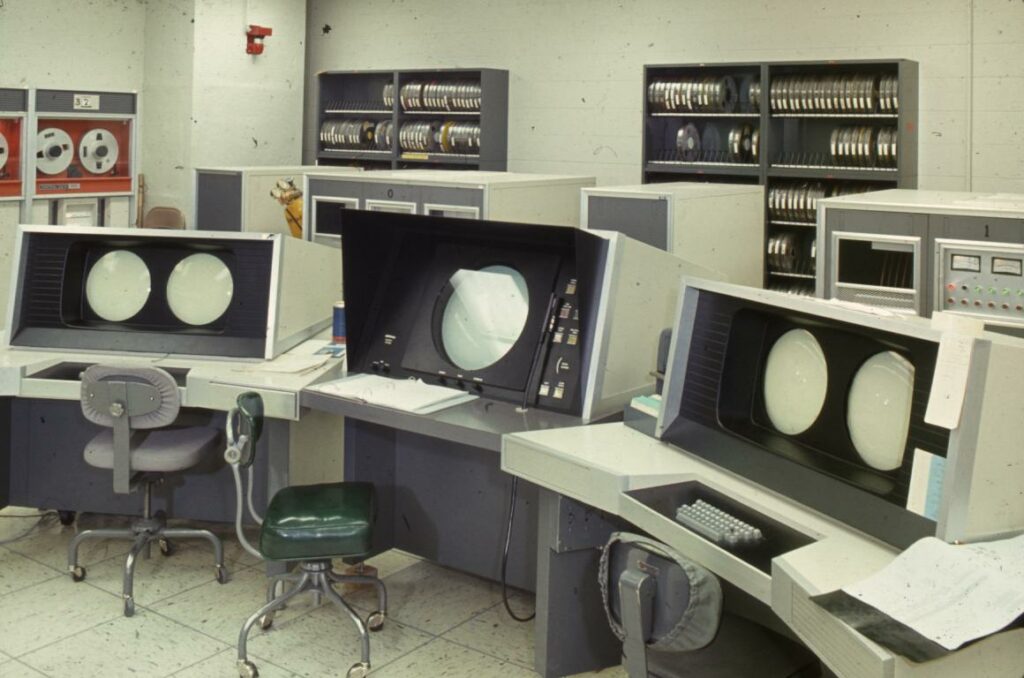
When I started this blog, I jumped directly to what I thought was the first wargame of the first PC : Tanktics. I was aware of earlier games on mainframe computers, but they were for later and indeed since then I covered various Star Trek, Empire and even older, more obscure games. But naturally, there were many more that never made it to posterity, “making it to posterity” usually meaning being featured in one of David Ahl’s many “BASIC Games” books”. The sources for those forgotten programs are scarce : the meticulously curated user-contributed catalogues, particularly those of the Digital Equipment Computer User’s Society (DECUS), and isolated efforts to preserve some specific titles.
That’s until I began researching the SOL-20, a 1976 computer. Its history is well-documented by one website in particular which also lists more than two hundred programs for the SOL-20, including a fair amount of wargames. However, upon investigating further, I found out that most of these are not native to the SOL-20. Instead, they are often games created for mainframe computers which were painstakingly ported to SOL-20 from 1977 to 1983 by someone called Ralph Hopkins. In the early 2000s, Hopkins donated his collection to the owner of the SOL-20 website, providing an incredible window into the kind of content students could find on mainframes.
I could not find anything on the Internet about Ralph Hopkins, but he meticulously documented all his ports, preserving the names of the original authors and the date of their creations. For instance, the code of Warfish starts with the following comment :
1 REM WFISH.ECB
2 REM -- PROGRAM DESIGNED BY RANDY WITT, RURAL RT 2,
3 REM -- JANESVILLE, MINNESOTA, 56048. "WARFISH" WAS
4 REM -- COMPLETED ON FEBRUARY 9, 1973.
5 REM -- THE BOOK "WAR FISH" BY GEORGE GRIDER, C/R 1958,
6 REM -- LITTLE, BROWN & CO., BOSTON, PROVIDED THE
7 REM -- INSPIRATION FOR THIS PROGRAM.
8 REM ======= LAST CORRECTED 06/20/77 R.E.H.From this, we gather a few hints about Hopkins. He likely lived or worked in Eagon, Minnesota, and judging by the abundance of programs ported which he tagged “MECC” (for Minnesota Educational Computing Consortium), he might have served as a system operator or computer engineer in one of Minnesota’s educational institutions – only someone in such a position would have had the access time required to port all these programs.
Post-War Minnesota was possibly the most advanced place in terms of computing technology, thanks to the now-forgotten role of a company called Engineering Research Associates (founded in 1946) which worked on classified code-breaking projects for the US Military with the aid of computers. Federal funding, the concentration of high-level engineers, and the growing demand for specialized components lured tech firms from all United States to set up a branch in Minnesota and gave rise to numerous new companies. The latter included Seymour Cray’s Control Data Corporation (CDC), which in 1964 produced the first commercially successful supercomputer : the CDC 6600. It was within this context that the MECC was established.
In 1963, some University of Minnesota teachers began introducing computers in their classrooms through terminals connected to a mainframe in Dartmouth College. This initial venture proved successful and was replicated throughout Minnesota, leading to the establishment of the MECC by the State Legislature in 1973 to coordinate what had been thus far individual initiatives. The goal was to ensure that every school in the State would have a terminal connected to a single computer center – initially a UNIVAC 1100 – in Saint Paul, thus constituting the MERITSS (Minnesota Educational Research and Instruction Time Sharing System) network. As it soon turned out, the State of Minnesota slightly underestimated the demand from the students, eager as they were to study American history with the help of Oregon Trail (1971, but with an official MECC version in 1974) or, I guess, trigonometry with the numerous variations of Star Trek. While many other universities frowned upon gaming (Sid Meier for instance narrowly avoided being disciplined by the University of Michigan because of a print-out of his Tic-Tac-Toe) the MECC understood its value. The popularity of the system forced the MECC into a race to develop not only its reach but also its capacity. At its peak, MERITSS became the largest educational timesharing system in the world, supporting up to 448 simultaneous connections from as many as 2000 terminals across the State.
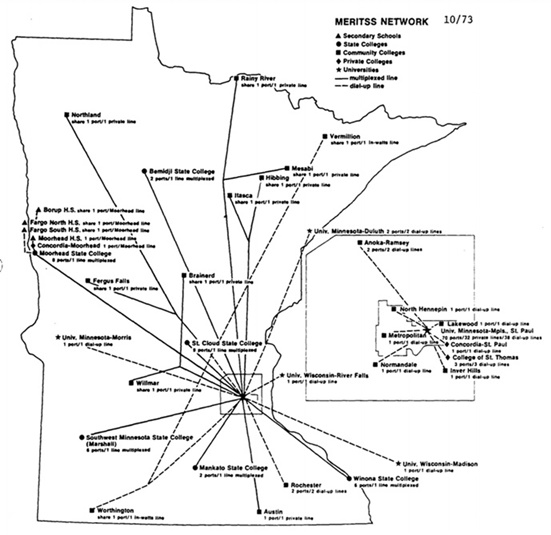
My Early Bytes of Creativity series of articles will focus on the games (not necessarily Minnesotan) from the golden era, starting in 1973 and ending in the early 80s, when the MECC gradually switched from maintaining a central computer and local terminals to providing Apple II in every classroom. Given the sheer number of games, I will cover one theme in each article, starting today with the submarine games, none of which are exclusive to Ralph Hopkins’ collection. The truly forgotten games will be brought to light in later articles.
Warfish (1973)
The earliest of today’s games is Warfish, attributed to Randy Witt from Janesville in Minnesota. It is a simple proto-wargame with only 3 commands :
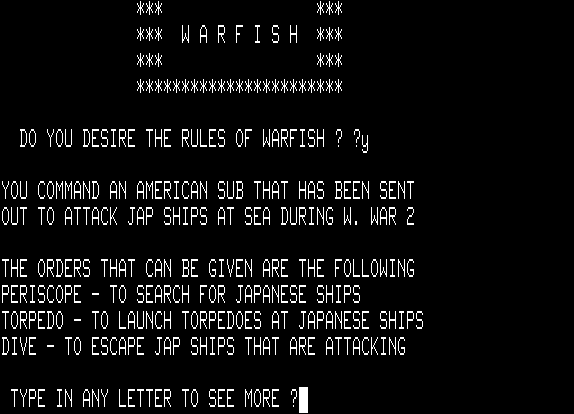
The game then asks you to name your sub (I went for “USS Trout“) and immediately puts you at sea. A “Periscope” command later, I detect my first target : a Japanese tanker !
It is not like I have a lot of options, especially since I can only use “Dive” when under attack, so torpedoes it is. Three salvos of two torpedoes later my target is sunk !
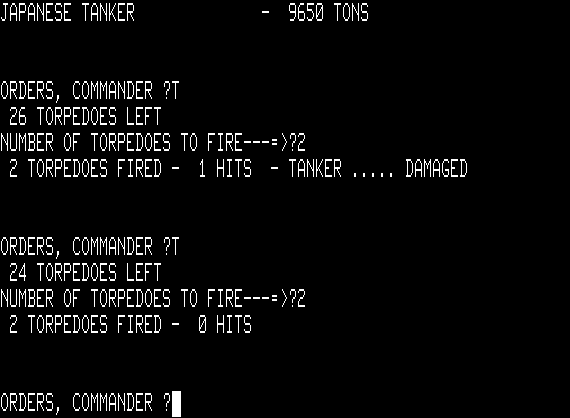
Without any sort of transition, I am then attacked by a Japanese Torpedo Boat, which I escape by diving.
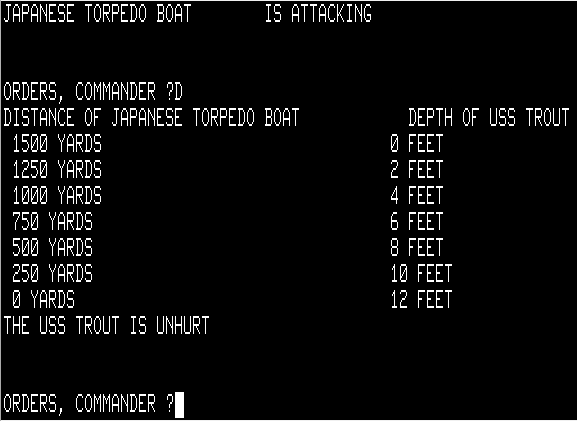
The USS Trout then encounters another Japanese tanker, easily sunk like the previous one. Alas, it is the last success of the USS Trout, as she encounters a destroyer escort (=a small destroyer) which sinks her with depth charges.
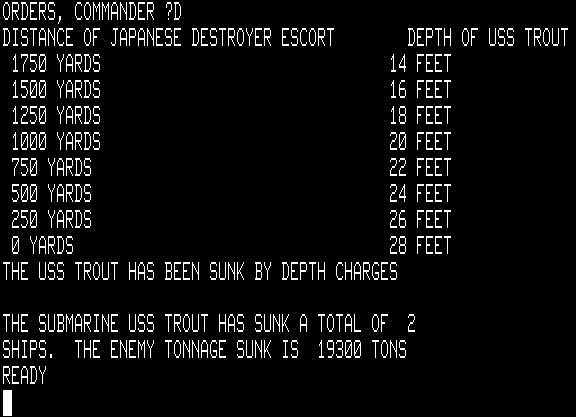
An earlier test had ended better for me – if the submarine is not sunk the game ends after the player exhausts all their torpedoes.
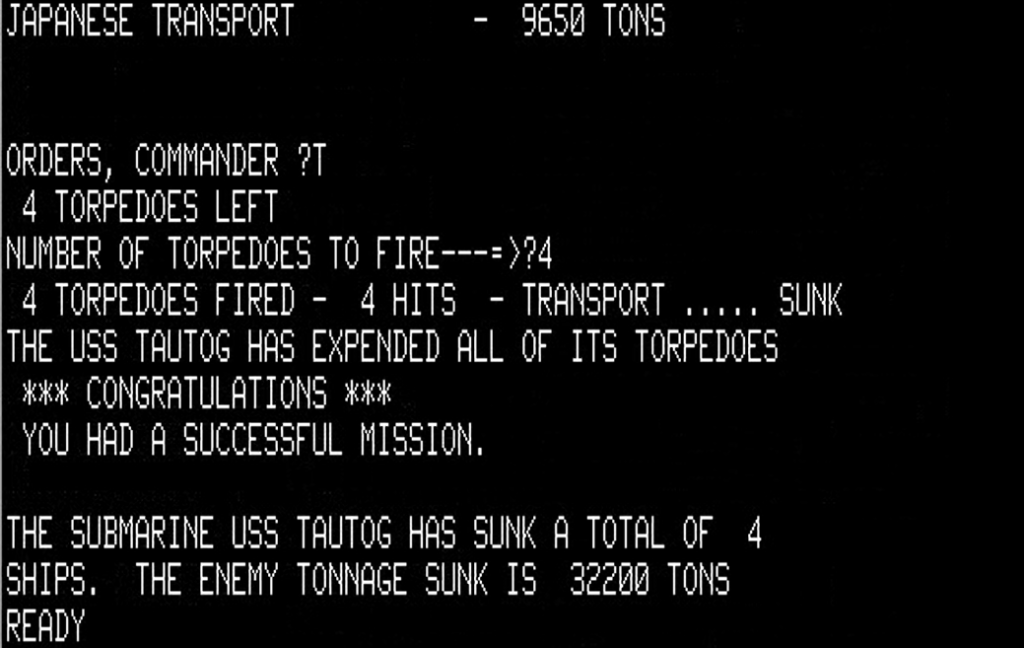
That’s all the game has. It is not much of a game, the only real “decision” is whether to dive or to send a large salvo of torpedoes when encountering an escort. The more torpedoes, the higher chance to sink the escort (but failure will get you rammed 100% of the time) but of course it leaves fewer torpedoes to sink higher tonnage targets.
Warfish is featured both in Ralph Hopkins’s dump and in David Ahl’s “More BASIC Computer Games” (1979), where the name of the author is spelt Wit rather than Witt. I played Ralph Hopkins’s earlier version, but the differences are marginal.
Convoy (1977 ?)
Convoy pits the player’s submarine against a transport and two destroyers : one remaining close to the ship, the other on a more distant patrol :
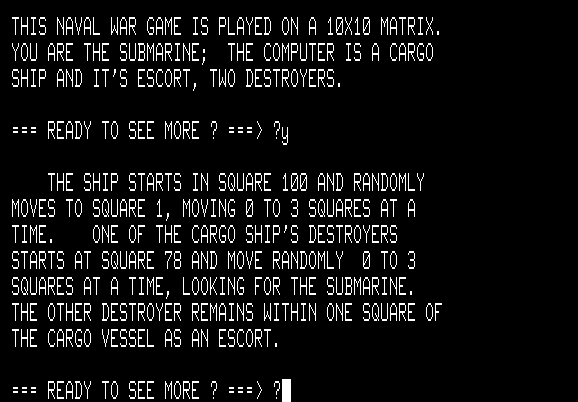
Everything happens on a 10×10 grid. My submarine moves by up to two cells twice in a row. After each movement, I am notified if I am next to an enemy. I can also rely on random reconnaissance reports to locate enemy ships. The enemy moves by 1 to 3 cells once (the distant destroyer) or twice a turn (the cargo and its close escort), and if any of the destroyers are ever on the same cell as I am, it is game over.
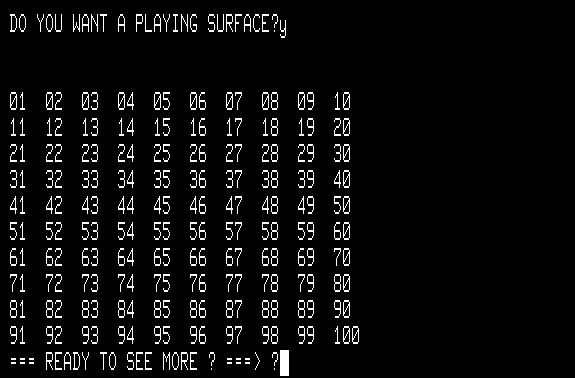
I have 4 torpedoes to sink the transport, but I allocate one of those torpedoes to the distant destroyer – an easy picking as she is not very mobile.
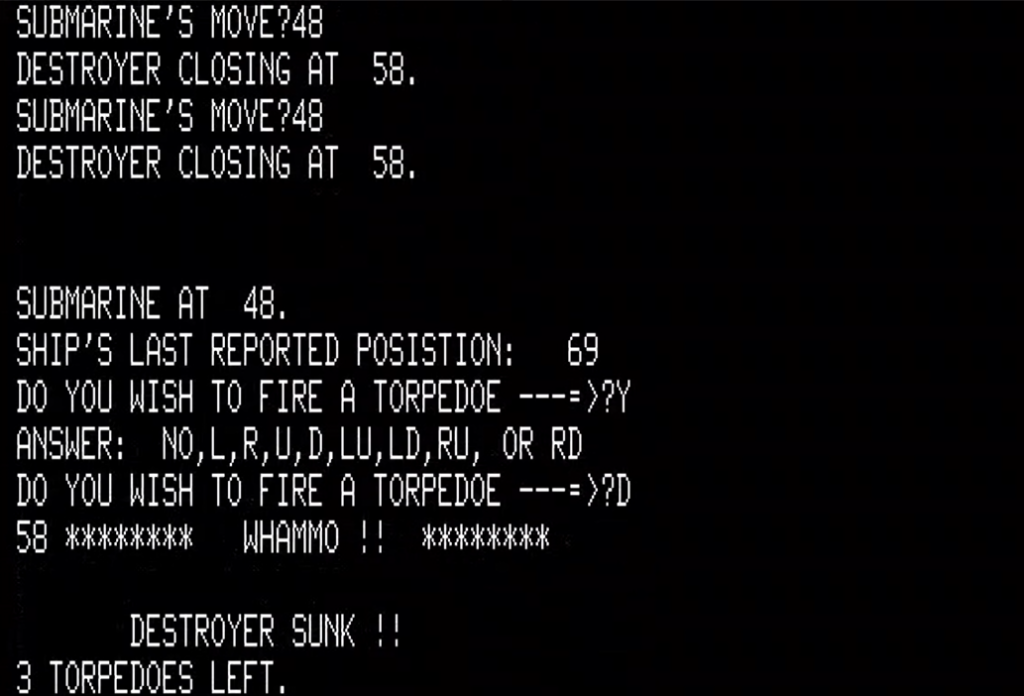
That’s the easy part. Sinking the transport on the other hand requires a lot of luck. First, unlike the distant destroyer, the player is never told the exact position of the close escort but only that it is nearby. Even worse, the transport and her escort move between your own movement and your torpedo attack, and you will not, under any circumstances, be informed of its new location, so you need to fire blindly.
After a lot of unsuccessful trials, I have determined that the convoy often “hugs” the border of the map, probably because it picks a random direction and does not move if its movement is blocked by the border of the grid.
In my final winning session, I first wasted two torpedoes trying to sink her on the right column, to no avail…

… but repositioning, I manage to sink the transport with my last torpedo on the bottom row:
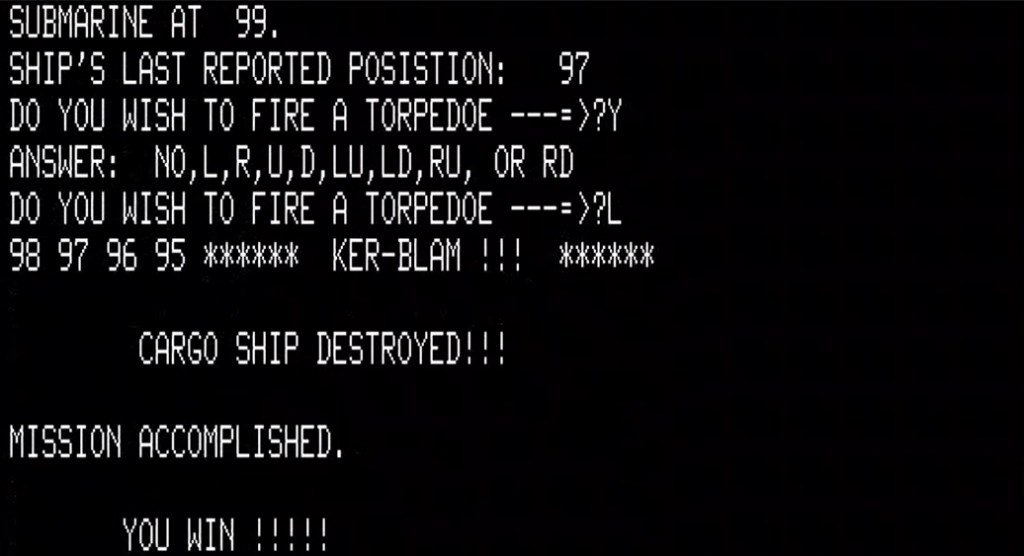
It is harder than it looks, this was my 15th attempt !

It was interesting, though it played more like a boardgame than like a strategy game.
Convoy can be found both in Ralph Hopkins’s dump (under the name SUB-F) and in David Ahl’s “More BASIC Computer Games“. Hopkins notes that the initial creation date is unknown but that he finished porting it to SOL-20 in 1977 and Ahl’s book has no information at all. Hopkins’ versions seem older given the number of typos (and Hopkins isn’t prone to typos himself, based on his personal projects), but it could be Hopkins copying someone who copied the original Convoy. Ahl’s version also feels even harder, as I believe the convoy actually tries to cross the map and win rather than move randomly every turn.
Sea Battle (1978)
In Sea Battle, the player must clean a local grid of enemy warships while avoiding sea monsters and mines. Few people really understand how dangerous the life of a submariner still is.
I start blind, so the first thing I do is use my scanner to check the surrounding map !
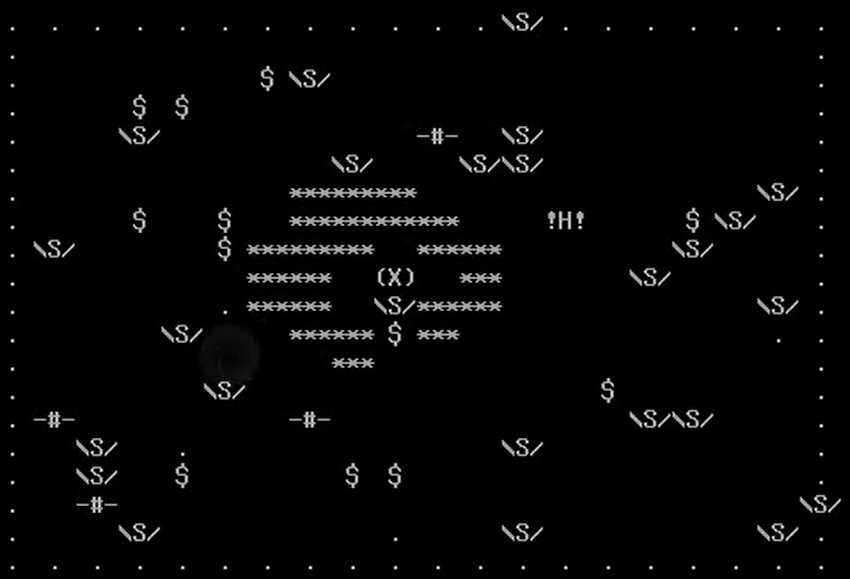
Uh oh ! I am the (X) in the middle of the lagoon, and I start with an enemy ship (\S/) immediately next to me on the other side of the ship, there is a mine ($) blocking the exit. My first action is to send two torpedoes, one for the ship and the other for the mine, destroying both.
Movements are simultaneous, so the enemy ship has the time to send depth charges before being destroyed, and I am damaged. Meanwhile, all the other ships and sea monsters (-#-) on the map live their own lives, attacking each other, blowing up on mines and, alas, destroying my HQ (!H!).
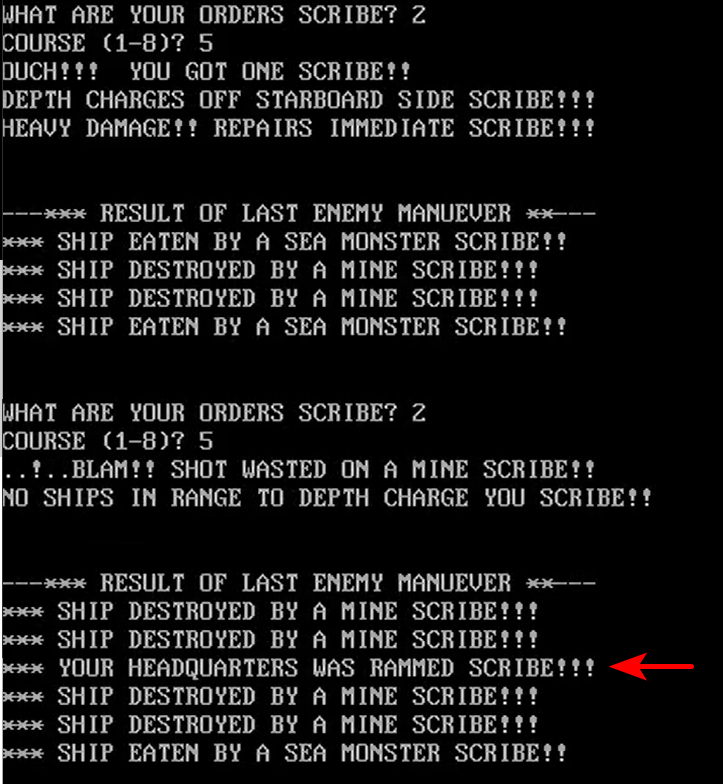
No more HQ means I only have my starting resources to sink all enemy ships – the difficulty of the game just increased a lot !
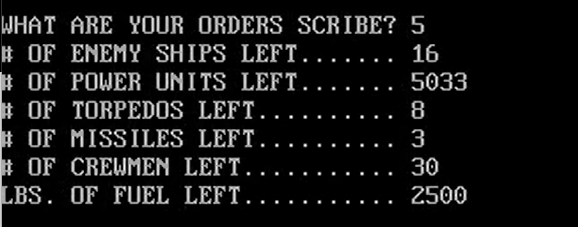
Unfortunately, I cannot update my map, because my sonar has been destroyed. Repair takes a while, time only pases by moving and moving costs me power (100 by cell). Without HQ, I have to win the game with whatever power I have left so I cannot waste it in safe back-and-forth while repairing. I blindly navigate out of the lagoon and hope not to be eaten/rammed/depth charged.
It turns out OK, and the sonar is eventually fixed :

There is an opportunity to do some damage in the bottom-left corner. Torpedoes only go straight in the usual 8 directions, but I have another weapon : the Polaris missiles. I have only 3 of them, but they blow up not only the cell on which they land on but also everything around them. They also have a long range (though it costs fuel to use), so I shoot toward my left :

I carry on and sneak without even realizing it pass one ship and one monster.
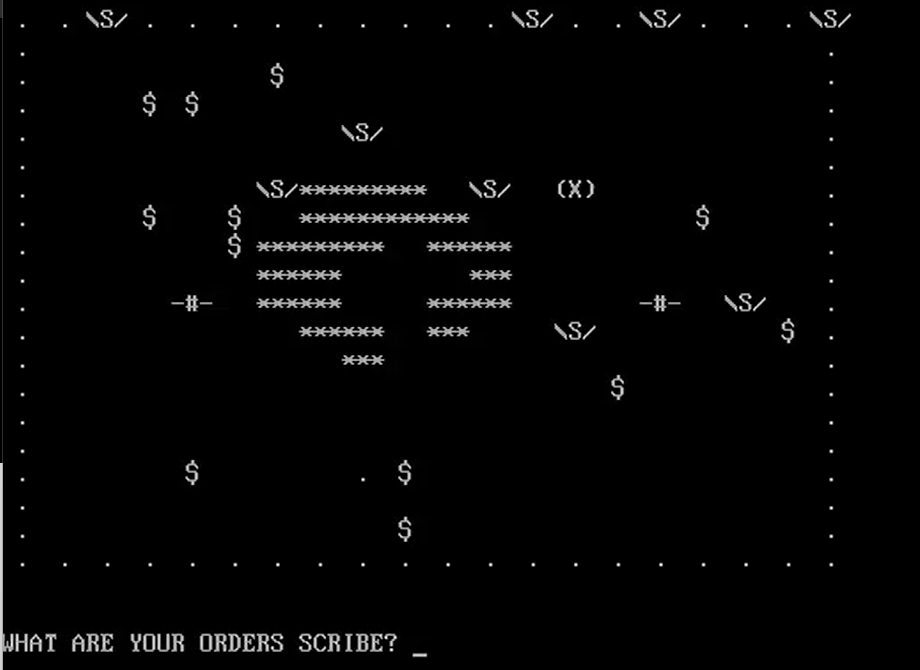
From where I am, there are two enemy ships ripe for receiving a torpedo. The problem is that sending torpedoes triggers enemy movement, which means one of my targets may escape. The solution is the last type of attack : sending divers to sabotage. The divers come from my crew of 30, and some of them may die, but using them does not trigger the end of a turn. I send divers to the left and a torpedo South.

The game carries on like this for a while, until there are only 2 targets left :
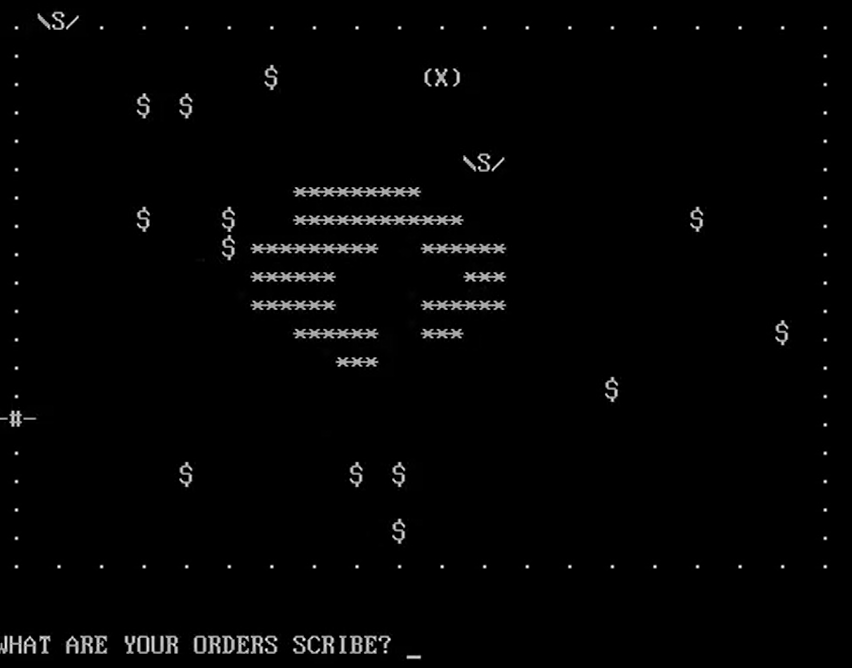
I manage to sink one of the two remaining ships, but I am also almost out of power and the survivor is on the other part of the map. I convert fuel into power (at 2:1 ratio) to get that extra spark I need to reach my last target…
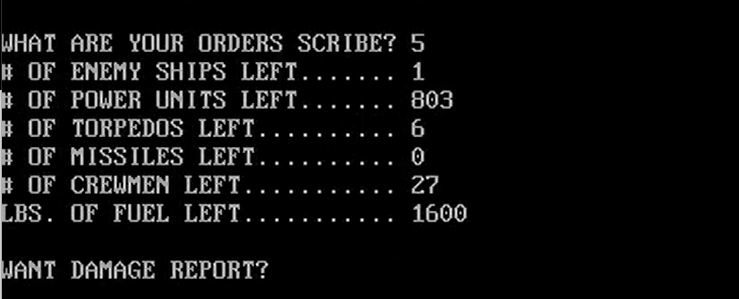
…and with no more fuel and less than 400 power left, I send that last torpedo, winning the game.

Seabattle is part of Ralph Hopkins’s collection but he notes his version comes straight from Ahl’s “More BASIC Computer Games“, where it is the largest game proposed. It was possibly intended to be the equivalent of the Super Star Trek that could be found in 101 BASIC Computer Games, it sure plays a bit like it. According to the introduction, it was coded by the 18-year-old Vincent Erickson, “a senior in Simley Senior High School in Inver Grove Heights, Minnesota”. The Simley Senior High School has kept its yearbooks and I found out that Erickson was a senior in 1977-1978, so the game was written possibly in 1977, probably in 1978. Checking the code, the game has a few hidden features : pressure creating all sorts of malfunctions when diving too deep (but I did not see the point of either diving or surfacing), areas that could become radioactive or the capacity to request help by flawlessly typing a pretty long code. It is a fun game, though not very hard if your HQ survives (3 victories out of 5 sessions). It can be played online here.
That’s all for today. I checked a few other “sub-themed” games, but I would not call them solitaire wargames :
- SUB-W (last modified in 1977, author unknown) from Ralph Hopkins’s collection is a two-player game where the players need to hit targets by guessing the correct torpedo speed
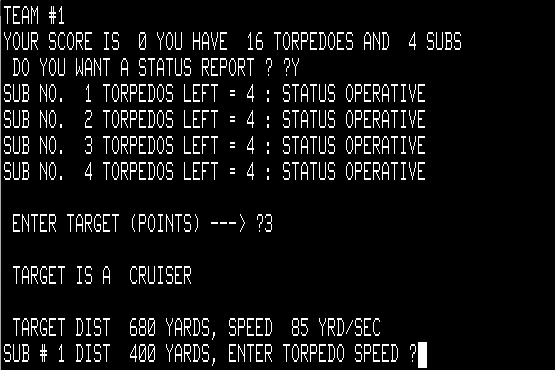
- SEAWAR (1975, author unknown) from More BASIC Computer Games is a classical artillery game :
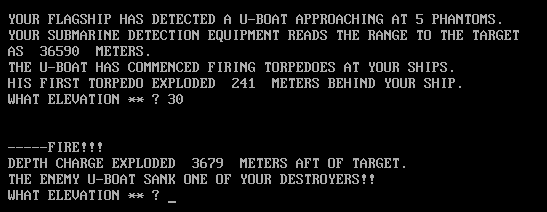
Still, we are not done with the mainframe games. In a coming article, I will check the air & land-themed wargames, leaving space last. But those of you who want less ASCII in their graphics will be happy to know that my next article will be about Archon.
I would like to thank commenters LanHawk and Porkbelly for their help on understanding the MECC and mainframe in general. I also thank Ralph Hopkins, wherever he may now be.
Source for the history of the MECC and Minnesota :
The documentary Solid State : Minnesota’s high-tech history
The article How Saint Paul was almost Silicon Valley
The website Minnesota Computing History
This first-hand account of using the MERITSS network to game.